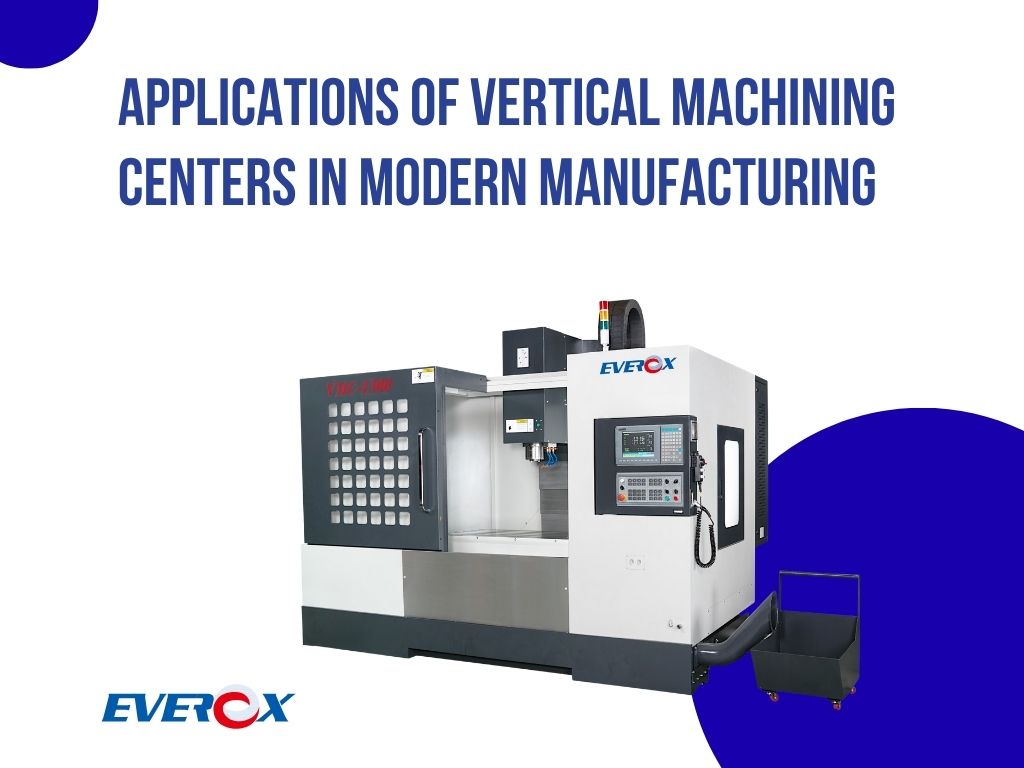Applications of Vertical Machining Centers in Modern Manufacturing

Introduction: The Role of Vertical Machining Centers in Precision Engineering
In today’s fast-paced manufacturing world, flexibility and accuracy are more important than ever. The vertical machining center (VMC) has become a cornerstone of modern machining due to its versatility, compact design, and ability to handle complex components across multiple industries. From mold making to aerospace and automotive production, VMCs play a vital role in creating precise, repeatable, and high-quality parts.
At EVEROX Industrial Co., Ltd., we understand that manufacturers today face increasing pressure to deliver precision, productivity, and reliability—all within tighter deadlines. That’s why our vertical machining centers are designed not just as machines, but as complete production solutions. With our engineering expertise and commitment to innovation, EVEROX continues to develop VMCs that combine structural rigidity, intelligent control, and user-friendly operation to help customers achieve higher machining efficiency and accuracy across every industry.
1. Mold and Die Manufacturing
One of the most common applications of vertical machining centers is in mold and die making. These industries require exceptional precision and fine surface finishes. VMCs excel in cutting complex 3D contours, cavities, and cooling channels used in plastic injection molds, die-casting dies, and stamping tools.
High-speed spindles and precision ball screws allow manufacturers to achieve micrometer-level accuracy, while advanced tool path control ensures uniform surface quality. Many mold makers now use 5-axis vertical machining centers, which enable intricate undercuts and curved surfaces to be produced in fewer setups—saving time and improving repeatability.
2. Automotive Components
The automotive industry relies heavily on vertical machining centers for engine parts, transmission housings, brake components, and structural frames. These components demand a balance between strength, weight reduction, and dimensional precision.
Modern VMCs with high-torque spindles and automated pallet changers enable high-volume production while maintaining tight tolerances. In addition, CNC-controlled cutting parameters reduce tool wear, ensuring consistent part quality over thousands of cycles. Manufacturers also take advantage of multi-axis machining for complex parts like cylinder heads or EV motor housings, where precision cooling passages or bearing seats are essential.
3. Aerospace and Defense
The aerospace industry places some of the highest demands on machining technology. Components such as turbine blades, landing gear parts, and engine housings must meet strict quality standards while being machined from hard-to-cut materials like titanium and Inconel.
Vertical machining centers equipped with high-rigidity structures, thermal compensation systems, and advanced vibration damping can handle these challenging materials effectively. CNC control ensures smooth tool engagement, optimal chip removal, and perfect geometrical accuracy. Moreover, 5-axis VMCs allow the machining of contoured aerodynamic surfaces in a single setup—critical for reducing lead time and maintaining process integrity.
4. Precision Tool and Equipment Manufacturing
Beyond mass production, vertical machining centers are widely used in precision tool, fixture, and equipment manufacturing. Industries such as semiconductor production, medical device fabrication, and optical component machining depend on ultra-precise jigs, molds, and tooling components.
The combination of direct-drive spindles, linear guideways, and servo-driven axes ensures vibration-free performance and micron-level accuracy. CNC programming also enables quick switching between product types—an essential feature for manufacturers serving multiple customers or product lines.
5. General Metalworking and Custom Parts Production
For job shops and contract manufacturers, a vertical machining center represents the perfect blend of flexibility and capability. Whether producing prototypes, small-batch parts, or repair components, VMCs provide the agility needed to adapt to diverse customer requirements.
Their vertical configuration simplifies setup and maintenance, while automatic tool changers and digital controls streamline the production process. Combined with CAD/CAM integration, even small workshops can achieve industrial-grade precision and productivity.
EVEROX Vertical Machining Centers: Stability and Precision Redefined
At EVEROX, our Vertical Machining Center (VMC) series exemplifies the marriage of stability and precision. Built on a Meehanite cast-iron column, saddle, and base, each machine features a rib-reinforced box-type construction for exceptional rigidity and vibration damping.
Precision linear guideways on all three axes and backlash-free ball screws driven directly by servo motors ensure consistent accuracy even during high-speed operation. The combination of structural strength and precise motion control makes the EVEROX VMC series ideal for demanding applications in aerospace, automotive, mold making, and general metalworking.
☞ Learn more: EVEROX Vertical Machining Center
Conclusion: A Reliable Workhorse Across Industries
From small toolmakers to global manufacturers, the vertical machining center continues to prove its value as one of the most versatile and efficient machines in the metalworking industry. Its ability to combine high accuracy, robust performance, and multi-industry adaptability ensures it remains at the core of modern manufacturing operations.
As production demands evolve toward higher complexity and precision, VMCs—especially those enhanced with CNC control and automation—will continue to shape the future of machining technology.
✉ Contact EVEROX today to learn more about our range of vertical machining centers designed for accuracy, stability, and long-term productivity.